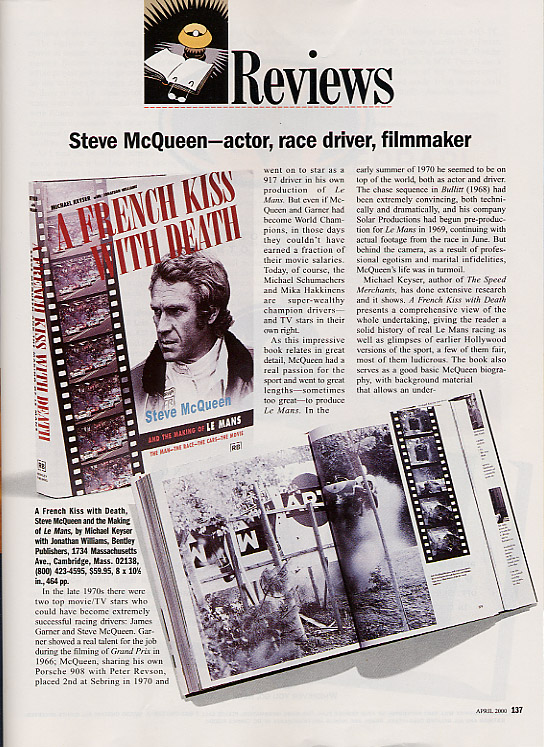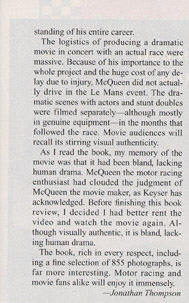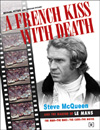|
A French Kiss With Death
Price: $99.95
|
Road & Track, April 2000
In the late 1970s there were two top movie/TV stars who could have become extremely successful racing drivers: James Garner and Steve McQueen. Garner showed a real talent for the job during the filming of Grand Prix in 1966; McQueen, sharing his own Porsche 908 with Peter Revson, placed 2nd at Sebring in 1970 and went on to star as a 917 driver in his own production of Le Mans. But even if McQueen and Garner had become World Champions, in those days they couldn't have earned a fraction of their movie salaries. Today, of course, the Michael Schumachers and Mika Hakkinens are super-wealthy champion drivers - and TV stars in their own right.
As this impressive book relates in great detail, McQueen had a real passion for the sport and went on to great lengths - sometimes too great - to produce Le Mans. In the early summer of 1970 he seemed to be on top of the world, both as an actor and driver. The chase sequence in Bullitt (1968) had been extremely convincing, both technically and dramatically, and his company Solar Productions had begun preproduction for Le Mans in 1969, continuing with actual footage from the race in June. But behind the camera, as a result of professional egotism and marital infidelities, McQueen's life was in turmoil.
Michael Keyser, author of The Speed Merchants, has done extensive research and it shows. A French Kiss with Death presents a comprehensive view of the whole undertaking, giving the reader a solid history of real le Mans racing as well as glimpses of earlier Hollywood versions of the sport, a few of them fair, most of them ludicrous. The book also serves as a good basic McQueen biography, with background material that allows an understanding of his entire career.
The logistics of producing a dramatic movie in concert with an actual race were massive. Because of his importance to the whole project and the huge cost of any delay due to injury, McQueen did not actually drive in the Le Mans event. The dramatic scenes with actors and stunt doubles were filmed separately - although mostly in genuine equipment - in the months that followed the race. Movie audiences will recall its stirring visual authenticity.
As I read the book, my memory of the movie was that it had been bland, lacking in human drama. McQueen the motor racing enthusiast had clouded the judgement of McQueen the movie maker, as Keyser had acknowledged. Before finishing this book review, I decided I had better rent the video and watch the movie again. Although visually authentic, it is bland, lacking human drama.
The book, rich in every respect, including a fine selection of 855 photographs, is far more interesting. Motor racing and movie fans alike will enjoy it immensely.
-Jonathan Thompson


![[B] Bentley Publishers](http://assets1.bentleypublishers.com/images/bentley-logos/bp-banner-234x60-bookblue.jpg)
